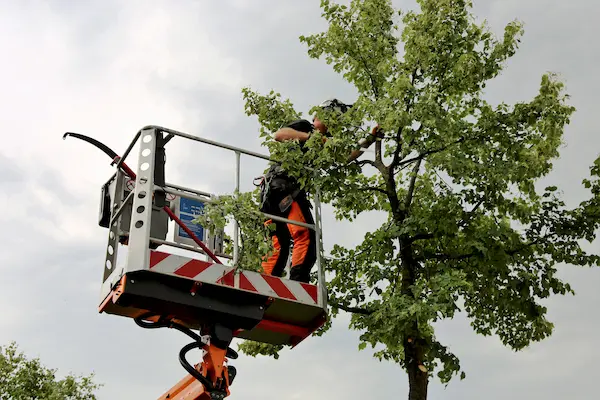
Did you know that timing is everything when it comes to pruning your trees? In fact, late winter to early spring is the sweet spot for tree pruning. This timing sets your trees up for success, allowing them to channel their energy into healthy growth when the warmer months arrive.
Pruning at the wrong time can potentially harm your tree or, in extreme cases, even lead to its demise. But don’t worry – we’re here to guide you through the process so your trees thrive for years to come.
At Anderson’s Tree Care Specialists, we’re all about keeping your trees healthy, happy, and looking their best. As your local tree care specialists, we’re here to share our expertise and help you make the best decisions for your leafy friends. Let’s dive deeper into why this timing works so well and how we can customize our approach for your specific San Jose trees.
Why Late Winter to Early Spring Is the Best Pruning Time
You want it to heal fast and stay healthy, right? That’s exactly what happens when you prune in late winter or early spring. Tree pruning is essentially a controlled injury to the tree, and our goal is to minimize stress while maximizing benefits:
- Dormancy Benefits: Trees are less active during this period, which means they can focus their energy on healing rather than growth or fruit production.
- Faster Healing: The approaching growing season allows trees to heal pruning cuts more quickly, reducing the risk of disease or pest infestation.
- Improved Structure: Pruning before new growth appears helps us shape the tree more effectively, promoting a stronger overall structure.
- Disease Prevention: Many harmful fungi and bacteria are also dormant during this time, decreasing the risk of infection through pruning cuts.
- Better Visibility: With leaves gone, it’s easier for our experts to see the tree’s structure and make precise cuts.
By the time spring is in full swing, your freshly pruned tree will be healed and ready to put all its energy into new, vigorous growth.
Different Trees, Different Ways to Prune
While late winter to early spring is generally the best time for pruning, we recognize that each tree species (and even individual trees) may have unique needs. Not all trees are created equal when it comes to pruning! Here’s a more detailed guide to help you understand the nuances:
- Evergreen Trees: Best pruned in late winter before new growth appears. These trees typically require minimal pruning, but when necessary, our careful touch ensures they maintain their year-round beauty.
- Fruit Trees: Prune in late winter to promote better fruit production and quality. Our experts understand the delicate balance between encouraging fruit growth and maintaining tree health, especially for popular San Jose varieties like apple, pear, and citrus trees.
- Young Trees: Early shaping is crucial for long-term health and aesthetics. We recommend pruning in late winter to establish a strong, healthy structure. Our team can help set your young trees up for a lifetime of beauty and vigor.
- Flowering Trees (Spring-Blooming): These trees, such as dogwoods and magnolias, should be pruned immediately after they flower. This approach avoids cutting off the next season’s buds while still allowing time for new growth. We’ll work with you to time this perfectly for your specific trees.
- Flowering Trees (Summer-Blooming): Prune in late winter or early spring for best results. This includes popular San Jose trees like crape myrtles and catalpa. Our pruning techniques will enhance both their flowering display and overall structure.
- Trees Requiring Specialized Pruning: Some species may need specific timing or techniques. For example, oak trees in the San Jose often benefit from pruning during their dormant season to prevent oak wilt. Our team is well-versed in the needs of local species and can provide tailored advice.
Remember, while these guidelines are generally effective, factors like tree health, age, and specific environmental conditions can influence the best pruning time. That’s why we always recommend a personalized consultation. Anderson’s Tree Care Specialists’s certified arborists can assess your trees and provide customized recommendations based on their species, condition, and landscape goals.
Need a Tree Pruning Estimate?
Click below to leave your information and we will call you right back!
Ready to schedule your tree & plant care service?
Leave your information below and we will give you a call back.
*During normal business hours. After hours calls will be returned the next business day.
When and Why You Should Not Prune
Whatever you do, avoid pruning in early fall. It’s like sending your tree into winter without a coat! Pruning too late in the year can leave your tree vulnerable to cold damage and disease.
Plants require adequate time to recover from pruning before the onset of winter, and fall pruning simply doesn’t provide this crucial healing period. Moreover, pruning cuts that haven’t fully healed can become vulnerable entry points for frost damage, ultimately weakening the plant’s natural defenses. These open wounds created by fall pruning can increase susceptibility to diseases that flourish in the cool, damp conditions typical of our city’s autumn weather.
Don’t Forget About Pruning Shrubs!
Just as the San Jose has its unique microclimates, each type of shrub and tree has its ideal pruning schedule. Let’s break it down:
Spring-Flowering Shrubs
- Ideal Time: Right after flowering
- Examples: Azaleas, Rhododendrons, Lilacs
- Why: Pruning after blooming preserves next year’s flower buds for a spectacular spring show.
Summer-Flowering Shrubs
- Ideal Time: Late winter to early spring
- Examples: Butterfly Bush, Rose of Sharon, Crape Myrtle
- Why: This timing promotes vigorous growth and abundant summer blooms, perfect for those warm San Jose evenings.
Evergreen Shrubs
- Light Pruning: Can be done throughout the year
- Major Shaping: Best in late winter
- Examples: Boxwood, Juniper, Holly
- Why: Winter pruning minimizes stress on the plant and allows for robust spring growth.
Rejuvenation Pruning
- Ideal Time: Late winter
- Best For: Overgrown or neglected shrubs
- Why: Heavy pruning during dormancy stimulates new growth, giving your shrubs a chance to revitalize with the coming spring.
Leave the Tree Care to Us at Anderson’s Tree Care Specialists
Remember, when it comes to tree pruning, timing is everything. It’s all about keeping them healthy and thriving for years to come. And that’s where we come in.
At Anderson’s Tree Care Specialists, we’re committed to providing the San Jose with expert tree care that’s rooted in science and tailored to our unique local environment. Whether you have a majestic oak that’s been standing for generations or a young fruit tree just starting out, we’re here to help your trees thrive. Our arborists know the local climate, soil, and common tree issues like the back of our hands.
We take the time to assess each tree, understand its needs, and create a pruning plan that’s tailored to its species, age, and health. So reach out to us today! Let us help keep your trees healthy, beautiful, and thriving for years to come.
Back to Tree PruningThe Best Time to Prune Your Trees: Our Guide in the San Jose Metro Area
Serving San Jose CA
San Jose | Fremont | Newark (CA) | Milpitas | Mountain View | Stanford | Palo Alto | East Palo Alto | Woodside | San Mateo | San Carlos
Redwood City | Los Gatos | Saratoga | Cupertino | Fruitdale | Campbell | Alamitos | Santa Clara | Coyote | Morgan Hill | San Martin | Gilroy
Home » Tree Pruning » The Best Time to Prune Your Trees: Our Guide



